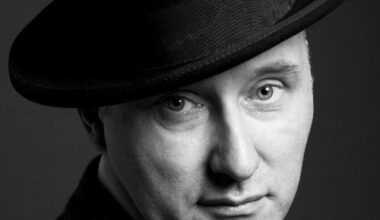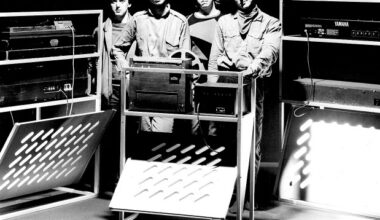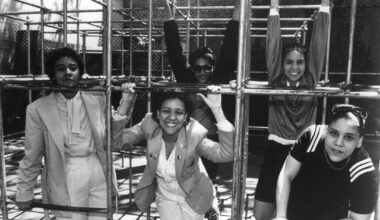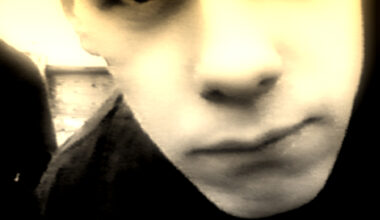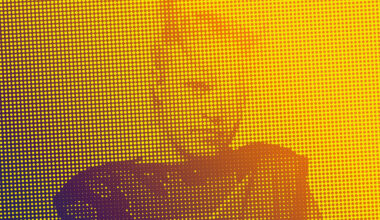John L Walters spills the beans on Landscape’s insanely catchy electropop hit ‘Einstein A Go-Go’

“We were already a well-established, touring instrumental jazz-rock band, but when we discovered electronics we reinvented ourselves as a studio project. We decided to concentrate on recording and experimented with all this new electronic gear in our spare time, which didn’t adapt well for playing live. Each instrumental track had a particular atmosphere and we’d add vocal elements to make it into more of a story. My original idea was that it would be a half-spoken thing, a bit like an Ian Dury song.
“The title came from John Warwicker, who designed our logo and first two album covers. John studied art at Camberwell, and he used ‘Einstein A Go-Go’ as the title of some black and white Christmas cards he sent out in 1978. He later joined Freur, founded design collective Tomato and collaborated with Underworld. Richard James Burgess took my original instrumental with vocal bits, which included the signature Lyricon [an electronic wind instrument] tune, and restructured it to work better as a pop song. We came up with the nursery rhyme-like tune and wrote the two verses and intro/outro chant together. The band then developed the sound, but our roles often changed radically because we didn’t have to worry about playing it live. Richard and I have written loads of things together over the years, so the process is quite fluid. Although I like working with words, I was always more of an instrumental composer, and quite slow, whereas Richard is a very quick thinker.
“We all had an interest in production, and self-produced the track along with the rest of the ‘From The Tea-Rooms Of Mars ….’ album. We never enjoyed being produced by other people, and as we were quite experienced in the studio, RCA trusted us not to blow the budget. We used nine studios to make the album, including Townhouse, with its famous drum room, Utopia, Nova Suite, Odyssey and Redwood, where the Monty Python albums were made, and where we did the telephone recordings that open the track. Those are all genuine calls I made to the Israeli Embassy and the White House on an old Bakelite telephone. We mixed the track at Jam Studios with our very patient engineer John Etchells, and did the programming in Camberwell at my home and Richard’s place, a few streets away.
“Although we’d had lots of studio experience, there was a degree of naivety too, as the kit was completely new back then. Our journey with electronics started with the release of ‘European Man’ in 1980, which actually had the serial number EDM1, as in electronic dance music. Richard co-invented the first standalone electronic drum set, the hexagonal Simmons SDS-V, with Dave Simmons. At the time it was so new it just had all these open circuit boards with jack leads hanging out. Occasionally Dave would drop by with a soldering iron and screwdriver to fix it.
“We enjoyed experimenting, such as miking the room to give that big ‘in your face’ sound, which made it a great radio track, and doing things like miking up the Lyricon to make it sound more human, catching the sound of the keys and breath. In a way, we created instruments that didn’t exist by holding down a keyboard chord and putting it through a gate that was triggered by a drum pulse, for example. We even had a slogan pinned to the studio wall that said, ‘No Middle Ground’.
“The beast that drove all the tracks was the Roland MC-8 MicroComposer, the precursor of the 303 and the 808. We would handwrite code on square maths paper, and then wait 20 minutes to save everything. Once there was a thunderstorm and we lost everything and had to reprogramme it all from scratch. Everyone played synths on the track. Our trombonist Peter Thoms delivered the husky ‘Einstein A Go-Go’ vocal. This was the first track we recorded with no trombone on it, so we had to find a role for him. I originally imagined it sounding more like The Temptations or something, but actually when we heard it we just all broke up laughing. It sounded so fantastic and distinctive.
“We never played the song live, but mime troupe Shock, who appeared in the video, used it in their shows, and people remember hearing them play it, which certainly helped it along. Our label RCA were incredibly hands-off. They saw us as a nice little niche jazz band, so it rubbed its hands together when ‘Einstein A Go-Go’ became a hit. The weird thing about the Lyricon tune is that I still occasionally hear people whistling it. I turn around thinking it’s an old friend winding me up, and the whistler turns out to be a builder or a postman. I think one of the reasons it drilled itself into people’s brains is that it’s a big jigsaw of hooks, tunes and riffs that all locked together.
“We never made anything quite like it again. My late friend and mentor Ian Carr described the song as ‘almost like a folk tune’, in that people remember the tune but don’t always remember who wrote or played it. It’s possibly the only novelty pop song about global religious nuclear terrorism, which all seems rather sadly topical today. Listening back now, 37 years on, I’m struck by how short and tight it is. I think it’s not too bad actually.”
